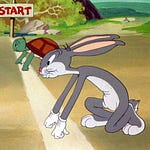Hey, gang! Longtime readers will see something new here: an audio file attached to this post. I’m dipping my toe into the world of podcasting, but combining it with the blogging that I know well. The result of this unholy union is something I’m calling Big Dave’s Small Bites — a short article and a mini-podcast that work together to explore a topic from a few different angles. This week’s post features some more thoughts on the Olympics, combined with some content from my Healthy Happy Hour live series. Feel free to read, listen, or both! Enjoy!
Last week, I was watching my niece compete in the Olympics (did I mention my niece was in the Olympics?) along with some of my family members via Zoom. She represented Team USA in rowing — an event that covers 2000 meters and takes six minutes from start to finish.
“It’s funny,” my cousin said, “during the race, they don’t look like they’re working that hard, but once they cross the finish line, they just collapse of exhaustion!”
It’s true — rowing, when done well, looks effortless, almost mechanistic, in its repetition of precise movements over and over. But paradoxically, it takes a helluva lot of effort to make it look effortless. Success depends on a unique combination of strength, cardiovascular fitness, and the technique to apply both efficiently.
Looking at these rowers, with their chiseled shoulders, arms and legs, and not an ounce of body fat, there’s no doubt that they are world-class athletes through and through. And after the race, I flipped through the other sports coverage and I found it interesting to see the wide variety of events, wide variety of world-class athletes, and wide variety of body types, each well-suited to the work at hand.
It all got me thinking about muscle fibers. In my recent interview with Dr. Ben Boccicchio, we discussed the different types of muscle that are in the body — no, not just thigh-muscle-connects-to-the-shin-muscle type of stuff, but the actual fibers that comprise each and every one of the muscles in your body. This gets a little deep, but here goes…
a muscle is a muscle, right?
What comes to mind when we think about “muscles?” Probably Popeye with a gullet fulla spinach and a bicep swelling to the size of a tank. But the fact is, we all have muscles all over our bodies, and what they looks like, and how they work, depends on how we use them.
Let’s take two ends of the spectrum. First, think of a stocky powerlifter (say, Hidilyn Diaz, who last week became the Philippines’ first-ever Olympic gold medalist). Compare that to a skinny 50k race-walker (which is apparently a thing). Two world-class athletes, two very different bodies, each uniquely adapted to the demands of their sport.
This speaks to the fact that — broadly speaking — power muscles are different from endurance muscles. The thick muscles that create quick bursts of speed and strength, (of the type that’s needed to lift a barbell over your head or sprint 100 meters) are known as fast-twitch muscle fibers. Then there are the long, lean muscles that are able to go for hours and hours at slower speed, (say, in a marathon or triathlon). These are called — you guessed it — slow-twitch muscle fibers.
Another set of terms you might hear when it comes to muscles is aerobic and anaerobic. This refers to how the muscles produce energy. Very simply put, aerobic energy production uses oxygen to create energy. This efficient process is the “default mode” for most activity, be it reading on the couch or walking around the block. Anaerobic production, on the other hand, requires no oxygen; it turns glycogen (sugar) directly into energy. This less-efficient process is sort of like a backup system: the deep reserves that we use in “fight or flight” situations, like lifting a car bumper to save a kid trapped underneath, or sprinting down the aisle at Costco to grab the last rotisserie chicken.
When I spoke with Dr. Ben about it, he used the more scientific terms of Types 1 and 2, with Type 1 being the slowest of the slow-twitch, and Type 2B, the fastest of the fast-twitch.
During our interview, I shared Dr. Ben’s table, which I call, “More Than You Ever Wanted to Know About Muscle Fibers.” As you can see, Type 1 fibers are the most aerobic, and Type 2B are the most anaerobic. (Types 2A and 2A/B are somewhere in between).
It’s probably best if I let him explain in his own words. Click the Play button above to hear Dr. Ben talk us through the chart — not just the science, but how he uses it as a teaching tool, and what it means in real life.
muscle and exercise
Researchers have found that the leg muscles of world-class sprinters are comprised of as much as 75% Type 2 fibers, while marathoners’ muscles can be up to 80% Type 1. This accounts for the obvious physical differences between, say, Usain Bolt and Eliud Kipchoge. Most of us mere mortals, though, have an even 50-50 split.
So what does that mean for our exercise routine? Should we don a leotard and “get physical” with some aerobics? Or break out the kilt and pick up some big rocks at our local Highland Games? Predictably (and frustratingly) enough, the answer is, “it depends” — in this case, on what outcome you’re trying to achieve. The training routine for a powerlifter looks very different from that of a race-walker. According to most studies, a 2000-meter rowing race is around 80% aerobic and about 20% anaerobic, so elite rowers often use a mix of training that mirrors that proportion.
For us normal humans, there are benefits to both kinds of exercise, and our particular goals will determine how we work out. But according to Dr. Ben, there are some unique advantages to taxing our Type 2B muscle fibers, which means that we should make like the Eagles and “take it to the limit” a couple of times per week.
Next time, I’ll get into the idea of training Type 2B fibers, including an overview of Dr. Ben’s SMaRT workout program, which I’ve been using lately and really enjoy. In the meantime, shoot me an email or write a comment below and let me know what you think of this post and this format.
Thanks for reading!
- Big Dave
PS: Don’t forget to check out Dr. Ben’s amazing book, 15 Minutes to Fitness, and his website at www.drbenbo.com
PPS: And while you’re reading stuff, why not look at my book, My Unremarkable Brain, now available wherever books are sold. And don’t forget to leave a review!














Share this post